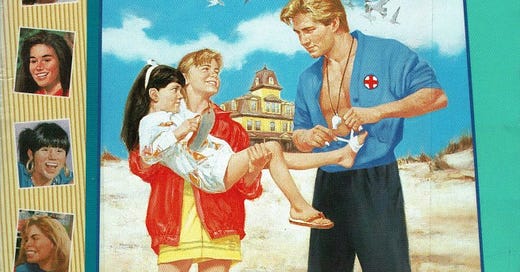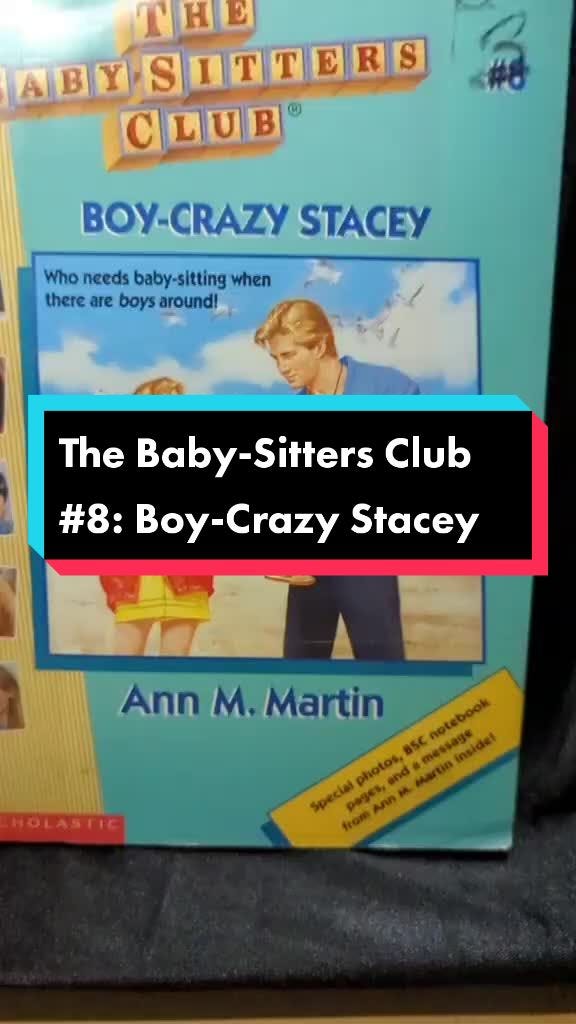The Baby-Sitters Club #8: Boy-Crazy Stacey by Ann M. Martin
Complete candor upfront — growing up, I had a difficult time relating to Stacey McGill. I had something in common with every other babysitter. I was Asian American and a daydreamer like Claudia Kishi and a west coast girl like Dawn Schafer. I had the responsibility of Kristy Thomas and the social awkwardness of my favorite Mary Anne Spier. My sister and I seemed like Abby Stevenson and her sister, although I was more Anna than Abby. I always had my nose between the covers of a book and wrote stories that I kept with me wherever I went like Mallory Pike. And finally, Jessi and I shared a sense of humor.
Stacey, on the other hand, was beautiful and boys liked her — neither of which were true about me. Stacey was distant and foreign to me — a gorgeous nymph in a waterfall that I would never reach with my misshapen body. Or, at the very least, she was a popular girl in my class who would never speak to me in the first place.
As I got older, the only thing I remembered about her was that she had diabetes. When I thought back on the series, I said to myself, “Diabetes must have been a bigger deal back then.”
After reading The Baby-Sitters Club #8: Boy Crazy Stacey, I still think, “Diabetes must have been a bigger deal back then.” But I also see something in Stacey — her unwavering belief in the best in people and vulnerability because of her belief.
The book opens with Stacey and Mary Anne promising the other members of the BSC to write every day and send them postcards. The Pikes are going on a trip to Sea City, New Jersey and they hired the two as 24-hour babysitters for the eight Pike kids.
Eight kids. Mrs. Pike doesn’t work. Two-story suburban house. Beachfront vacation house. Seven kids and Mr. Pike’s mystery job.
He is clearly in the mob. He offed some stooly and his mob boss paid for a trip to Sea City, which is close to Atlantic City. That is the only explanation for his ridiculous life, even during the halcyon days of the 1980s. How can a ten-person family where the mother doesn’t work possibly afford this vacation with two 24-hour babysitters? Illegally, that’s how.
But I digress. There are eight Pike children that Mary Anne and Stacey have to corral around Sea City. The youngest is Claire, 5, followed by Nicky, 8, Margo, 7, Vanessa, 9, the triplets Jordan, Byron, and Adam, 10, and finally, future BSC member, Mallory, who is 11. I had to write down all these children’s names, but Martin does make it easy for the reader to remember who is who. Mallory is the most mature one. Jordan, Byron, and Adam are little jerks. Vanessa rhymes all the times. Nicky wants to emulate his brothers, Claire is obnoxious, and Margo is miscellaneous. That’s how I kept track of them.
Stacey goes over a few of the items she’s bringing along with her to Sea City, one of which is something called “Sun-Lite.” Apparently, if her parents found out she had a “Sun-Lite” bottle, her Mother would murder her. I had no idea what “Sun-Lite” was and I still don’t. A Google search brings me to a lighting company. When I modify my search to add “hair” I get a Florida hair salon. From context clues, it seems to be some kind of bleaching agent. Ann M. Martin fails to explain what it is and this isn’t the last time I came across something I had never heard of.
Chapter 3 starts with our first handwriting section. Stacey asks if Kristy likes the postcard, which is apparently, “wild.” I don’t know about you, but I’ve never seen a “wild” postcard. Maybe if it had a nude lady on it. To be fair, there isn’t a description of the postcard, so I guess it could be a nude lady. If you’ve seen a “wild” postcard, let me know in the comments.
The chapter is the car ride from Stoneybrook to Sea City — including a scene where Mr. and Mrs. Pike exchange instructions. Now he’d just plug in the ice cream stop into his phone and follow the directions. Some of the children get sick, sending me into flashbacks. The Pikes have a puke bucket. My family had a puke can.
At the end of chapter three, we are greeted with a lovely passage.
“The Pikes fell into silence as we entered Sea City. They looked awed, and I could see why. Their senses were suddenly overloaded with great kid stuff: the smell of hotdogs and fried food and the sea air, the sounds of the waves and of kids shouting and laughing and calling to each other, but mostly the sights. We passed Trampoline Land and miniature golf and souvenir stands. We passed stores and restaurants and ice-cream parlors. And in the distance was a boardwalk with arcades and a Ferris wheel and a roller coaster and probably plenty of head-spinning rides. And beyond all that gleamed the ocean.”
I was in. The description was exactly what I thought a family destination called Sea City would be. The exception is “Trampoline Land.” I hated the name and I couldn’t figure out what it was. Just an unsafe trampoline in the middle of the beach? This was obviously a time before trampoline misuse amputation. It doesn’t really matter, the children never venture into Accident Waiting to Happen Land.
Chapter 4 is where Stacey meets Scott, the handsome lifeguard. Stacey is instantly smitten, like any 13-year-old girl. What girl hasn’t fallen in “love” with a much older boy? Usually, the admiration is from afar where a girl can daydream about him from a safe distance. However, Stacey actually talks to him after Claire cuts her foot on a shell and Scott the lifeguard has to patch her up. Scott the lifeguard says to Stacey, “I’ve been noticing you.”
I was nauseated. Stacey is thirteen. Thirteen! We learn later that Scott is eighteen-years-old. He is an adult. He is an adult who should know not to pick up girls who have just been introduced to the idea of different teachers for different classes.
I don’t blame Stacey — she’s just a girl with a crush. I blame him. He should know better. He should have just shrugged off her affections and got back to work making sure the beach is safe. Instead, he sends her on food runs only to garnish her with the useless trinket of his summer job — a five-cent whistle — and pet names like “babe,” “cutie,” and “princess.” Mary Anne remarks that the gift is stupid. I concur, gurl, I concur.
Stacey spends so much time with him that Mary Anne remarks on page 72:
“You’re getting paid as much as I am,” said Mary Anne in a huff, “and I’m doing all the work.”
Mary Anne is right. While Stacey is off fetching sodas for an adult man and giving him googly eyes, Mary Anne is with the children, watching over them and keeping them from venturing too far into the ocean. You know, doing the job Mr. and Mrs. Pike paid both of them to do.
Mary Anne and Stacey take the children to miniature golf. This was a bizarre passage. Martin takes the time out to explain miniature golf pars, but not “Sunlite,” “Noskate,” or “lipcoat.” The next chapter is a supplemental chapter featuring Kristy’s baby-sitting adventure. It mentions an “estate sale.” So, a kid may not know what “par” means, but would totally know what an “estate sale” is?
On the other hand, I love the postcards. The contrast between Stacey and Mary Anne’s approaches to the cards is stark and the way they write to other babysitters separates how they feel about the other characters. The cards are full of personality. They also tend to foreshadow the chapter. I genuinely enjoy the handwritten bits and I hope I feel the same way in the other books.
In chapter 10, we finally have the fall. Mr. and Mrs. Pike give Stacey and Mary Anne the night off, so the girls go to the boardwalk. We have another term I don’t understand — pedal pushers, which I just Googled and discovered that “pedal pushers” is another word for “capris.”
While on the boardwalk, Stacey discovers Scott making out with some other girl — a girl who is his age and obviously his girlfriend. Stacey is devastated.
The next day, Stacey doesn’t want to go anywhere. She spends the day with Byron, who has been having trouble relating to his brothers. Byron reveals he is afraid of the water. Stacey helps him get over his fear in a lovely scene in which they go for a walk. Stacey comes to the realization that Scott never loved her, but she’s more effusive about it than I was.
“I decided that Scott really did like me, but just as a friend. Or maybe even just as a cute kid.”
No, Stacey. He is an adult. He should have known better. He’s an adult man who took advantage of a child.
At the end of the book, Stacey and Mary Anne hang out with two boys who are appropriate ages. In the background of the book, Mary Anne met a boy named Alex, who was watching over his brothers and sisters. He has a cousin named Toby. Stacey and Toby hit it off. Here we have my favorite outfit of the book:
He was wearing plain white swimming trunks, but his shirt was amazing — tan with silly pictures of cowboy boots and cactuses all over it. And his sunglasses — black bands with narrow slits from side to side to see through.
So our Toby is a futuristic cowboy.
Mary Anne and Alex and Stacey and Toby go on a group date. The group splits and Stacey and Toby go on a Tunnel of Love.
For the record, I have never seen an actual Tunnel of Love ride in my life, but this is a popular trope.
In the Tunnel of Love, Toby kisses Stacey in a sweet first kiss scene. This old asshole smiled when I read it.
The girls say goodbye to their summer romances and return to Stoneybrook, where I’m reminded of how insane Stacey’s parents are. Sure, she had a ridiculous crush, but she took her medicine and ate responsibility. Stacey is a good person who has a disease that she treats with the severity it deserves. Her ability to navigate life with an intrusive disease is commendable and her parents should lay off a little.
Overall, I enjoyed the book, but I have a few issues.
I wish Stacey realized that Scott was taking advantage of her, but I don’t think Stacey is the kind of person to feel anger so quickly. She believed the best in Scott, even though he never earned that belief. She’s a better person than me.
Also, Martin explains the things like diabetes and what a par in miniature golf is, but not why Stacey’s parents don’t want her to have hair lighter, what “noskate” is (I Googled that one, too, to no avail), and other weird products. What are we supposed to know beforehand?
The handwritten parts were always a treat and I think it has a good message about expectations and responsibility. Kristy’s interlude was fun. Most of all, I’m happy to get to know Stacey better. Maybe this time around, I’ll find more common ground with the Treasurer of The Baby-Sitters Club.






